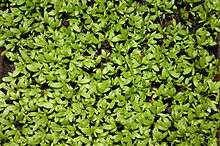Garden cress
| Garden cress | |
|---|---|
 | |
| Young plants | |
| Scientific classification | |
| Kingdom: | Plantae |
| (unranked): | Angiosperms |
| (unranked): | Eudicots |
| (unranked): | Rosids |
| Order: | Brassicales |
| Family: | Brassicaceae |
| Genus: | Lepidium |
| Species: | L. sativum |
| Binomial name | |
| Lepidium sativum L. | |
| Synonyms[1] | |
| |
Cress (Lepidium sativum), sometimes referred to as garden cress to distinguish it from similar plants also referred to as cress (from old Germanic cresso which means sharp, spicy), is a rather fast-growing, edible herb.
Garden cress is genetically related to watercress and mustard, sharing their peppery, tangy flavor and aroma. In some regions, garden cress is known as mustard and cress, garden pepper cress, pepperwort pepper grass, or poor man's pepper.[2][3]
This annual plant can reach a height of 60 cm (~24 inches), with many branches on the upper part. The white to pinkish flowers are only 2 mm (1/12 of an inch) across, clustered in branched racemes.[4][5]
When consumed raw, cress is a high-nutrient food containing substantial content of vitamins A, C and K and several dietary minerals.
Garden cress in agriculture
Garden cress is commercially grown in England, France, the Netherlands and Scandinavia.[6]
Cultivation of garden cress is practical both on mass scales and on the individual scale. Garden cress is suitable for hydroponic cultivation and thrives in slightly alkaline water. In many local markets, the demand for hydroponically grown cress can exceed available supply, partially because cress leaves are not suitable for distribution in dried form, so they can only be partially preserved. Consumers commonly acquire cress as seeds or (in Europe) from markets as boxes of young live shoots.[6]
Edible shoots are typically harvested in one to two weeks after planting, when they are 5–13 cm (2–5 in) tall.[7]
Culinary
| Nutritional value per 100 g (3.5 oz) | |
|---|---|
| Energy | 134 kJ (32 kcal) |
|
5.5 g | |
| Sugars | 4.4 g |
| Dietary fiber | 1.1 g |
|
0.7 g | |
|
2.6 g | |
| Vitamins | |
| Vitamin A equiv. |
(43%) 346 μg (38%) 4150 μg12500 μg |
| Thiamine (B1) |
(7%) 0.08 mg |
| Riboflavin (B2) |
(22%) 0.26 mg |
| Niacin (B3) |
(7%) 1 mg |
| Pantothenic acid (B5) |
(5%) 0.247 mg |
| Vitamin B6 |
(19%) 0.247 mg |
| Folate (B9) |
(20%) 80 μg |
| Vitamin C |
(83%) 69 mg |
| Vitamin E |
(5%) 0.7 mg |
| Vitamin K |
(516%) 541.9 μg |
| Minerals | |
| Calcium |
(8%) 81 mg |
| Iron |
(10%) 1.3 mg |
| Magnesium |
(11%) 38 mg |
| Manganese |
(26%) 0.553 mg |
| Phosphorus |
(11%) 76 mg |
| Potassium |
(13%) 606 mg |
| Other constituents | |
| Water | 89.4 g |
|
| |
| |
| Percentages are roughly approximated using US recommendations for adults. | |
Garden cress is added to soups, sandwiches and salads for its tangy flavor.[7] It is also eaten as sprouts, and the fresh or dried seed pods can be used as a peppery seasoning (haloon).[6] In the United Kingdom, cut cress shoots are commonly used in sandwiches with boiled eggs, mayonnaise and salt.


Nutrition
Raw cress is 89% water, 6% carbohydrates (including 1% dietary fiber), 3% protein and less than 1% fat (table). In a 100 gram amount, raw cress supplies 32 calories and numerous nutrients in significant content, including vitamin K (516% of the Daily Value, DV), vitamin C (83% DV) and vitamin A (43% DV). Among dietary minerals, manganese levels are high (26% DV) while several others, including potassium and magnesium, are in moderate content (table).
Other uses
Garden cress, known as chandrashoor, and the seeds, known as halloon[8] in India, are commonly used in the system of Ayurveda.[9]
See also
References
- ↑ The Plant List: A Working List of All Plant Species, retrieved 8 May 2016
- ↑ Cassidy, Frederic Gomes and Hall, Joan Houston. Dictionary of American regional English, Harvard University Press, 2002. Page 97. ISBN 0-674-00884-7, ISBN 978-0-674-00884-7
- ↑ Staub, Jack E, Buchert, Ellen. 75 Exceptional Herbs for Your Garden Published by Gibbs Smith, 2008. ISBN 1-4236-0251-X, 9781423602514
- ↑ Vegetables of Canada. Published by NRC Research Press. ISBN 0-660-19503-8, ISBN 978-0-660-19503-2
- ↑ Boswell, John T. and Sowerby, James. English Botany: Or, Coloured Figures of British Plants. Robert Hardwicke, 1863. Page 215.
- 1 2 3 Vegetables of Canada. NRC Research Press. ISBN 0-660-19503-8, ISBN 978-0-660-19503-2
- 1 2 Hirsch, David P.. The Moosewood Restaurant kitchen garden: creative gardening for the adventurous cook. Ten Speed Press, 2005. ISBN 1-58008-666-7, ISBN 978-1-58008-666-0
- ↑ http://www.organicindia.com/PR_OH_chandrashoor.php
- ↑ The Wealth of Indian Raw Materials ,. New Delhi: Publication and information Directorate. 1979. pp. CSIR Vol 9, Page 71–72.